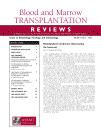 Cytomegalovirus Infection: The Day After and the Morning Before
Cytomegalovirus Infection: The Day After and the Morning Before
by John R. Wingard, Editor
The deadly consequences of cytomegalovirus (CMV) infection after hematopoietic stem cell transplantation (HSCT) are all too well known to those who trained in the 1980s or before. Those of us remember well the specter of a nonproductive cough and dyspnea suddenly appearing in an allograft recipient two to three months after transplantation. This was a time after transplantation when clinicians and patient alike were beginning to breathe a sigh of relief that the prospects for a successful outcome were bright. Such hopes were quickly dashed by rapid and relentless respiratory failure followed by death.
One of the remarkable success stories in the history of HSCT is the progress made in controlling the danger of CMV infection. Few patients today die from the direct consequences of CMV during the first 3 months after HSCT.
Yet, problems from CMV continue to linger even today. In this transcript of a symposium held at the 2004 Tandem BMT Meetings in Orlando, Florida, sev- eral less well studied consequences of CMV infection were discussed. Dr. Michael Boeckh presented data from several recent series indicating that even with the control of CMV infection, indirect effects remain, especially for high- risk patients, that result in a survival disadvantage. Such indirect effects are pre- sumably immunomodulatory, increasing susceptibility to other infections or other sequelae. However, these indirect effects of CMV infection, first noted in solid organ transplant recipients, are still poorly understood. Late onset of CMV infection, once infrequent, now is increasingly common, and only now are strategies being tested to address this.
The fact that these consequences remain “the day after” infection emphasizes the need for prevention of infection altogether when possible. This second topic was addressed by Dr. Garrett Nichols. Dr. Nichols reviewed the current status of methods of screening blood products for transfusion support, the effectiveness of various methods of filtering to reduce the risk of virus transmission, the promise of new testing, and the limitations of these various strategies. Although advances have been made in prevention of viral transmission, it is clear that more work is needed “the morning before.”
Download a PDF version of the full issue.
